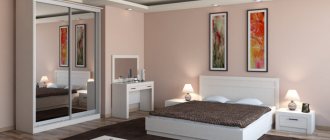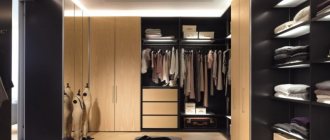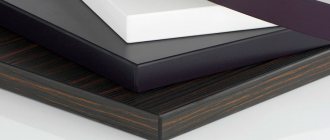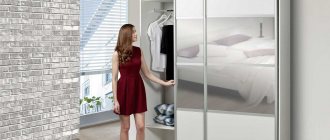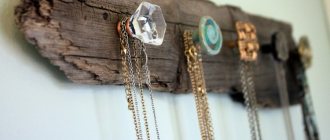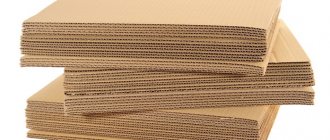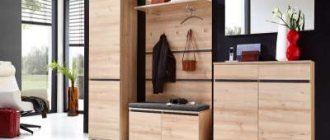It turns out that such an ordinary element of cabinet equipment as a rod has many nuances. If you make a mistake with the material, shape, or provide for incorrect installation, you may encounter undesirable consequences. So the rod in the wardrobe is the subject of detailed discussion today.
Let's talk about what they are, what they are made of, as well as how and at what height they are installed.
This will allow you to avoid common mistakes and ensure maximum efficiency from using the crossbar.
How much width space does clothing take up?
| 50 cm | 55 cm | 60 cm |
| not much, but possible | Fine | Very good |
* This is our down jacket (or fur coat). What about yours?
It is this size that, as a rule, limits the location of the clothes rail “along the back wall of the closet” and, accordingly, the internal depth of the closet.
The European standard for internal cabinet depth is 56 cm.
If your closet will store “light” outerwear (or children’s) clothing, such a rod can be used even with a shallower closet depth.
Important: sliding doors “eat up” approximately 10 cm from the full (external) depth of the cabinet. And here cabinets with regular hinged doors often come to the rescue.
Ladder
0
A charismatic garden ladder can replace not only a heated towel rail, but also a floor hanger. It can be painted, stained, glossy or matte varnish. Or you can leave it as it is - battered by life, winds and rains.
0
In a brutal loft you can afford clothes on a stepladder. However, be careful - we’ll end up sliding into a chair.
Clothes size by height
| Clothes height including hangers | Height | |||
| 160 cm | 170 cm | 180 cm | ||
| Trousers with hangers folded in half | 65 cm | 72 cm | 80 cm | |
| Trousers on a special trouser hanger | 110 cm | 118 cm | 125 cm | |
| Jumper | 70 cm | 80 cm | 90 cm | |
| Shirt | 80 cm | 90 cm | 100 cm | |
| Blazer | 75 cm | 87 cm | 100 cm | |
| Jacket “below the waist” | 80 cm | 92 cm | 105 cm | |
| Knee-length coat | 90 cm | 103 cm | 116 cm | |
| Coat “below the knees” | 120 cm | 130 cm | 140 cm | |
Choosing a place
When choosing a place for a cabinet, you should adhere to the “golden rule” - use all available space to the maximum, without going beyond the stylistic direction.
To properly position the hanging wardrobe, you should use all available space to the maximum, without going beyond the stylistic direction.
The ideal solution is if the closet completely covers one of the walls in the hallway.
A wardrobe hanger will help in storing not only outerwear, but also shoes.
Another, no less successful option is to install furniture in a niche. This is where the embedded model comes into play. You can install the cabinet with only one side against the wall. Quite a common arrangement due to the standard layout of apartments with interior doors.
One of the most successful options for arranging a hanging closet is to install it in a niche.
In corner structures, doors can be installed either diagonally or in a straight line. The latter option is optimal if the cabinet is located between two walls.
In corner structures, doors can be installed either diagonally or in a straight line.
When remodeling an apartment or house, you can always install a hanging closet, which will additionally perform a separating function.
The main thing when choosing a hanging wardrobe for the hallway is attractiveness and convenience.
The main thing when choosing a hanging wardrobe for the hallway is harmony, attractiveness, convenience, allowing you to place all the necessary things in such a small area as the hallway.
What are clothes rails and what materials are they made from?
The issue of storing clothes requires a rational and organized approach. To solve this problem quickly and effectively, a clothes rail is used, which is a special device that allows you to keep wardrobe items in order and clean. Ease of use makes it popular among consumers and owners of sliding wardrobes.
Styles
Hanging wardrobes, like any other furniture, must comply with a single design concept and be in the same style with other furnishings.
Hanging wardrobes must correspond to a single design concept of the hallway.
Cabinets with forged elements will suit the Baroque style. The classic design has clear lines and consistent shapes. It is allowed to have threads.
The classic design is characterized by clean lines.
Hanging wardrobes made from natural materials will fit perfectly into Provence or country style. The main condition is the color scheme, which should be light.
Hanging wardrobes will fit perfectly into the Provence style.
Art Nouveau welcomes fancy lines and shapes. The most suitable material for it is plastic or metal.
The minimalist style is very often used to decorate hallways.
Purpose and where it can be used
A modern clothes rail has one direct purpose - to neatly hang clothes in the closet. A large number of things is a problem familiar to every person. The use of hangers and hangers makes it easier to organize space in the wardrobe, and the rod allows you to place them.
To ensure that your closet is always in order and the search for the necessary clothes is not long, a rod is used. It is fixed along or across the garment, depending on its type. In addition, the use of two or three devices at once allows you to place wardrobe elements on several levels.
The clothes rail allows you to store:
- dresses - they are stirred by special internal straps;
- shirts - shoulder seams should be on the hanger, and buttons should be fastened;
- T-shirts – quick access to T-shirts will save time on ironing;
- blouses - should be positioned in the same way as shirts;
- outerwear - it will require reinforced hangers that can provide reliable fixation of jackets, coats and raincoats.
When selecting hangers, you should give preference to an anti-slip coating. This material will prevent clothes from rolling off their hangers and secure them comfortably in the closet.
Options located on the side panels allow you to conveniently organize the storage of ties, scarves and belts. A small gap between the fixture and the cabinet wall will save space. You can also additionally install second-tier rods and hang trousers and jeans on them. With this approach, the number of shelves in the closet will be reduced to a minimum.
Depending on the type of device, it can be used in two different ways: stationary and as an element of a wardrobe or wardrobe. The element finds another application in the dressing room as a separate element of the interior. The mobile rod for things conveniently moves around the room, and if necessary, hides in a secluded place. Hanging models are distinguished by their functionality due to the large gaps between the furniture panels: various types of clothing can be placed there.
Dummy
0
Floor hangers with hangers can be replaced with mannequins - real tailor's or decorative ones. Yes, you can’t hang a lot of clothes on them (this is not only a minus, but also a plus), but they look colorful. More colorful is the “model of a human skeleton for teaching and medical purposes.”
0
Variety of shapes
Dressing rods differ in their size, shape and arrangement. All existing species can be divided into several groups, taking into account their characteristics. To select a clothing storage device of the desired size and shape, it is recommended to review the classification summary table.
| Classification by shape | Types by type of fastening in a closet or dressing room | Classification by purpose |
| Oval is the most common option among users. This model is attached to a flange, which is fixed to the furniture board. The oval clothes rail has increased load capacity, which allows you to place outerwear on it - coats, winter jackets, down jackets. | Transverse – located in a closet or wardrobe system transversely to the product. Some cabinet owners do not accept this type, claiming that it is not convenient to use. On the other hand, this type of placement of the bar allows you to save space in the wardrobe, freeing it up for other things. | Retractable microlift - used in shallow cabinets, up to 50 cm deep. Convenience lies in the location perpendicular to the bottom, where one of the parts of the model moves forward, allowing a person to take the necessary thing. This device is fixed with self-tapping screws to the ceiling of the wardrobe system. |
| Round – fixed to the cabinet walls using special rod holders. This rod is suitable for storing medium-heavy items on hangers: blouses, shirts, skirts, trousers. | Longitudinal - a traditional rod for things, which is fixed parallel to the floor or bottom of the cabinet. It is comfortable to place hangers with clothes on it, and it is convenient to take them out at any time. | Pantograph - allows you to make the most efficient use of the entire cabinet space. Such a rod is attached near the ceiling of the wardrobe, and a special mechanism organizes the movement of the furniture elevator, thereby allowing you to get the right thing. |
| — | Floor-standing – is a separate structure that can be transported around the apartment. You can also hang hangers with clothes on the bar. This design is often used in theater dressing rooms. | A rod for accessories - such devices are placed on the doors of the wardrobe. It is convenient to store belts, scarves, ties and other items here. |
Zhenya Zhdanova Valet
0
A separate type of floor hanger is a floor hanger (valet hanger). This device is usually designed for one set of casual clothes and is located in the bedroom near the bed. These hangers are individual, that is, each family member will need their own hanger. Usually, hangers come with a pair of crossbars for storing trousers or skirts, and sometimes there is also a shelf for watches or glasses.
0
Practical materials
According to the production technology of clothing storage devices, all materials must be durable and reliable. Constant high load gradually pushes the bar, which can lead to its breakage. To prevent a sad outcome, it is recommended to take a closer look at the materials for the production of floor and hanging rods:
- Chrome steel is the most common material for clothing storage devices. The raw materials are highly reliable and can withstand heavy loads for a long time. If you install the product correctly, choosing the length of the rod correctly, it will last for many years without a single scratch;
- metal alloys - used for the production of rods for commercial purposes. For example, metal fixtures are well suited for organizing the storage of theatrical costumes, and can also serve as clothing racks in a store. Such a rod will be highly durable, but the appearance will not be attractive due to the lack of coating;
- galvanized steel. The production technology makes it possible to apply a special coating to the steel material, protecting the product from wear and corrosion. A hanging place for storing ties and scarves can be made from this material.
The method of installing the rod will depend on the parameters of the closet or dressing room. If it is narrow and small, it makes sense to use a longitudinal fastening. If the cabinet has good depth, you can perform a transverse installation.
Crossbar dimensions
See also
Lock for a sliding wardrobe: which one to choose, how to install it yourself
The issue of barbell size deserves special attention.
The length of the crossbar depends on the width of the furniture. Standard wardrobes usually contain pipes up to 1 meter long.
For large and spacious cabinets that require a long crossbar, be sure to use additional supports. The maximum permissible length without support is 150 cm.
And only on condition that the bar will not be used for hanging heavy clothes in large quantities.
Retractable structures vary on average from 250 to 500 mm.
